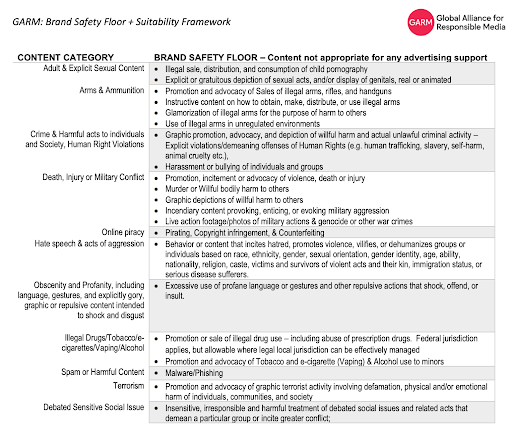Between the occasionally ruthless reactions online communities may have toward benign statements and rabid, uncompromising fandoms, the internet can be no cakewalk for brands.
The idea of getting canceled has many in the corporate world treading water, unsure of how to safely use marketing, including social media, to reach their consumers. This has led to an increased interest in brand safety practices, which gives brands more control over where their advertising content is placed. Brand safety means something different to every company, though plenty of best practices apply to everyone.
Let’s dive into the complexities of brand safety and how to keep your brand out of an unsavory spotlight.
What is Brand Safety?
The Interactive Advertising Bureau (IAB) defines brand safety as “solutions [that] enable a brand to avoid content that is generally considered to be inappropriate for any advertising…”
Brand safety vs. brand suitability
Brand safety is a term that is sometimes used interchangeably with brand suitability, and while these principles share some similarities, it’s important to understand the difference between them.
Brand safety focuses on avoiding content and environments that are offensive, harmful, or inappropriate in order to protect the brand’s reputation. Brand safety practices are relatively universal and apply to nearly all companies. For example, an advertisement appearing next to illegal content is likely not brand safe for any company, regardless of industry or image.
While brand safety is concerned with avoiding harm, brand suitability aims to form positive associations with relevant content and media. Brand suitability is unique to individual brands because every brand has specific positioning, target audiences, messaging, etc. For example, a health and fitness brand likely wouldn’t deem an alcohol delivery app a suitable place to advertise, even though alcohol isn’t necessarily an unsafe topic.
Preventing Harmful Brand Exposure
To help marketers protect their brands from harmful advertising situations, industry leaders such as the 4A’s Advertiser Protection Bureau (APB) and The World Federation of Advertisers’ Global Alliance for Responsible Media (GARM) have come together and developed a framework that outlines a brand safety floor and suitability risk levels. These are the types of content deemed inappropriate for any advertising support.
Additionally, here are two common pitfalls to avoid under the umbrella of brand safety.
User-generated extremism
Social media platforms like X (formerly Twitter) and TikTok can be valuable for brands looking to get their message to millions of engaged viewers. However, in recent years, the social media giants have come under close scrutiny for providing a home for extremist views to propagate unchecked. Businesses must now account for brand safety when advertising here, so consumers don’t relate their image to extreme viewpoints. Organizations like Check My Ads inform brands when their ads are broadcast in spaces that assist or affirm extremist views.
Cheap ad placements
The old adage is true: You get what you pay for. Publishers who offer premium advertising placements are more likely to promote brand safe content, so you likely won’t need to micromanage your entire ad campaign.
Publisher reputations are built on the quality of their content and it’s in their best interest to provide safe and efficient advertising opportunities for brands. So any damage caused by an unfortunate ad placement is something publishers are bound to take personally. This accountability can work in your favor.
On the flip side, a publisher with a cheaper inventory of ad placements may simply take what they can get without any incentive to promote brand safety. Plus, if you’re only buying cheap ad placements, you may actually be wasting your ad spend on made-for-advertising (MFA) websites. These MFA websites utilize bot traffic and other tactics to artificially inflate traffic and orchestrate fake performance metrics that brands typically look for in order to siphon ad dollars from advertisers unknowingly. You should avoid any publisher that manipulates its numbers this way.
Quick Tips to Improve Brand Safety
In today’s digital world, there are plenty of ways for your brand’s messaging to wind up in unseemly situations. Here are a few quick points to help you learn from brands’ past mistakes:
Leverage an ad verification solution: Several third-party vendors that offer brand safety protection such as Integral Ad Science, DoubleVerify, Comscore, and Pixalate. These vendors provide tools such as keyword blocking, pre-bid filtering, and curated segments to help brands avoid content that they don’t want to associate with. It’s true that these solutions aren’t 100% accurate, but they do offer some protection for highly sensitive brands.
Maintain a list of websites that are not suitable for your brand: Most companies will benefit from an advertising strategy that includes programmatic advertising. However, one drawback is that you don’t have visibility into the websites where your ads will be displayed until after your ads run. Whether you’re doing direct ad buys with publishers or using programmatic advertising, it’s wise to keep an active list of sites that you don’t want your ads to serve on. Most ad tech partners should offer the ability to exclude domains that you don’t want your ads shown on.
Partner with a marketing platform with rigid brand safety guidelines: Platforms like AdRoll feature a robust system of guidelines, so both a brand’s ads and its online placements follow carefully considered standards. Content featuring adult themes, disingenuous claims, and fraudulent practices are not allowed on the platform. A partnership with AdRoll ensures your ads build the image you want, forging a bond of trust between your brand and the consumers you rely on.
Launch Your Brand Marketing With AdRoll
Top-notch brand safety protocols and safeguards are just one of many reasons thousands of brands trust AdRoll to drive results and revenue. Create, manage, and measure campaigns across channels — all from a single, easy-to-use platform. Learn more today.
Last updated on January 12th, 2024.

